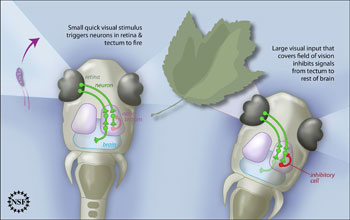Multimedia Gallery
Comparison of Neural Circuit
Comparison of a neural circuit activated by a small, quick cue versus a large one in zebrafish larvae.
Small, prey-like items elicit a quick response from zebrafish larvae, as excitatory brain cells fire. However, large visual stimulus covering the zebrafish's field of vision fires off inhibitory cells, and the zebrafish responds less to it. This mechanism allows the zebrafish to have a good hunting response to the appropriate visual cues, and not bite off more than it can chew.
This image accompanied NSF press release
"The Zebrafish's Neural Circuit Prevents It From Biting Off More Than It Can Chew."
Credit: Zina Deretsky, National Science Foundation
Images and other media in the National Science Foundation Multimedia Gallery are available for use in print and electronic material by NSF employees, members of the media, university staff, teachers and the general public. All media in the gallery are intended for personal, educational and nonprofit/non-commercial use only.
Images credited to the National Science Foundation, a federal agency, are in the public domain. The images were created by employees of the United States Government as part of their official duties or prepared by contractors as "works for hire" for NSF. You may freely use NSF-credited images and, at your discretion, credit NSF with a "Courtesy: National Science Foundation" notation.
Additional information about general usage can be found in Conditions.
Also Available:
Download the high-resolution JPG version of the image. (157 KB)
Use your mouse to right-click (Mac users may need to Ctrl-click) the link above and choose the option that will save the file or target to your computer.

